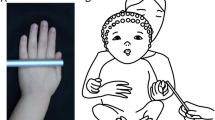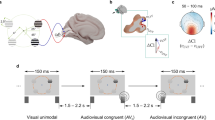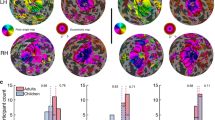Abstract
The primate visual cortex, including that of man, receives separate input from each eye and these interact in binocular cortical neurones. This organization is known to be vulnerable to disruption in early life1. To understand the development of human visual cortex, and to detect and assess disorders of binocular function at the earliest possible age, a robust method is needed for detecting binocular interactions in the infant's visual system. We have done this by recording cortical visual evoked responses (VERs) to the onset and offset of binocular correlation in a large-screen dynamic random dot display. We report here that, in general, the human infant has a functional binocular visual cortex by 3 months of age, with some individuals showing cortical binocularity at an earlier age.
This is a preview of subscription content, access via your institution
Access options
Subscribe to this journal
Receive 51 print issues and online access
$199.00 per year
only $3.90 per issue
Buy this article
- Purchase on Springer Link
- Instant access to full article PDF
Prices may be subject to local taxes which are calculated during checkout
Similar content being viewed by others
References
Hubel, D. H. & Wiesel, T. N. J. Neurophysiol. 28, 1041–1059 (1965).
Julesz, B., Kropfl, W. & Petrig, B. J. opt. Soc. Am. 68, 1420 (1978); Proc. natn. Acad. Sci. U.S.A. (in the press).
Lehmann, D., Skrandies, W. & Lindenmaier, C. Neurosci. Lett. 10, 129–134 (1978).
Miezin, F., Myerson, J., Julesz, B. & Allman, J. Vision Res. (in the press).
Bodis-Wollner, I., Julesz, B. & Kropfl, W. Pap. 28th int. Congr. on Physiological Science, Budapest (1980).
Julesz, B. Foundations of Cyclopean Perception (University of Chicago Press, 1971).
Atkinson, J., Braddick, O. & French, J. Invest. ophthalmol. & Vis. Sci. 18, 210–213 (1979).
Aslin, R. N. J. exp. Child Psychol. 23, 133–150 (1977).
Fox, R., Aslin, R. N., Shea, S. L. & Dumais, S. T. Science 207, 323–324 (1980).
Atkinson, J. & Braddick, O. Perception 5, 29–38 (1976).
Pettigrew, J. D. J. Physiol. 237, 49–74 (1974).
Vital-Durand, F., Garey, L. J. & Blakemore, C. Archs. ital. Biol. 116, 444–448 (1978).
Banks, M. S., Aslin, R. N. & Letson, R. D. Science 190, 675–677 (1975).
Author information
Authors and Affiliations
Rights and permissions
About this article
Cite this article
Braddick, O., Atkinson, J., Julesz, B. et al. Cortical binocularity in infants. Nature 288, 363–365 (1980). https://doi.org/10.1038/288363a0
Received:
Accepted:
Issue Date:
DOI: https://doi.org/10.1038/288363a0
This article is cited by
-
Stereo vision and strabismus
Eye (2015)
-
Infants’ sensitivity to vertical disparity for depth perception
Optical Review (2013)
-
Binocularity in infancy
Eye (1996)
Comments
By submitting a comment you agree to abide by our Terms and Community Guidelines. If you find something abusive or that does not comply with our terms or guidelines please flag it as inappropriate.



